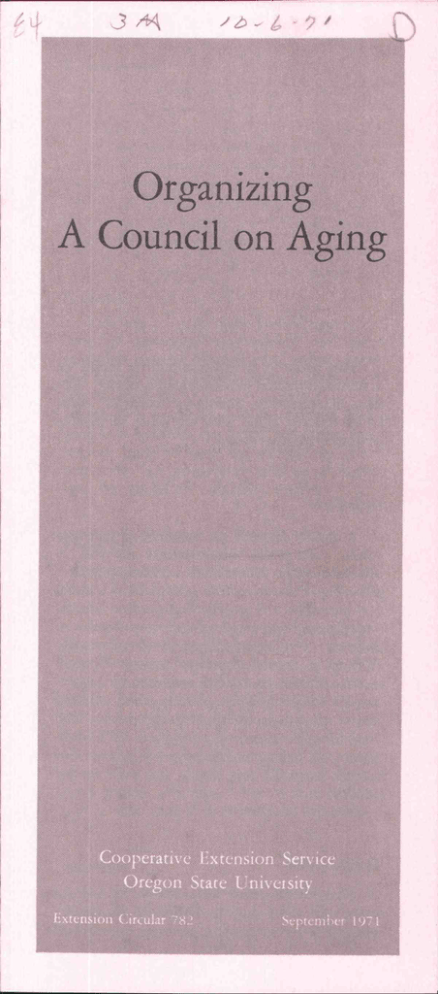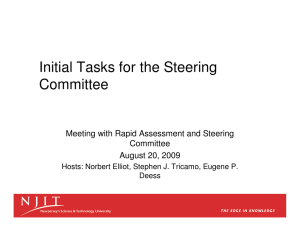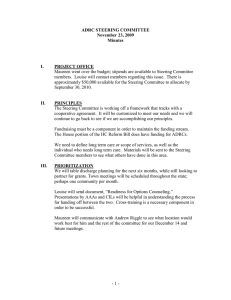Aging Organizing on A Council
advertisement

Organizing A Council on Aging This is one of a series of leaflets based on experience gained in the Lincoln County, Ore- gon, Community Self-Help Program with Older Adults, along with the study of similar programs in other areas. Definition A county Council on Aging is an incorporated, non-profit organization serving a county's senior adults. The council is both a planning and an action group. The council first identifies the needs of the senior adults, such as part time employment, low-rent housing, or a transportation service, usually through a person-to-person survey. Council members then meet with community organizations to get help in planning and starting action programs to meet these needs. The council maintains a close liaison with state groups on aging, and is aware of what other county councils are doing for their senior citizens. Organization Form a Steering Committee. In a rural area, one good way to begin to organize a council is by forming a steering committee. Visit people in each community and ask for suggestions of people to serve on this committee. Try to interest as many senior citizens as possible. The community will be more willing to lend its support if the seniors help them- selves first. If there are people in leadership roles already working with senior citizens, in- clude them on the steering committee. Training Steering Committee Members. Bring these steering committee members together for a training session on ways to recruit council members. Discuss the proposed council, why it is important to the county, and how it will operate. Committee members should approach prospective members by telling them as much as they can about plans for the council and then see if they are interested in it. Interest the steering committee members in going back to their communities and holding similar training sessions. Ask each one to find individuals interested in the council, particularly the senior adults, and schedule them for talks to civic groups, business organizations, and churches. Point out that people may join as an individual member, as a group member, or as a sustaining member. Once a volunteer steering committee is or- ganized, committee members should visit other councils in the state to see how they were formed, to study the bylaws and learn pitfalls to avoid. The steering committee should function until council members know one another and the council's jobs well enough to elect permanent officers. It is a convenient way of avoiding pitfalls that may develop by using "permanent personnel" from the start. Officers Most councils have officers, standing committees, members, and members-at-large. As a minimum, a president, vice-president and secretary-treasurer are needed. Consider retired senior adults with executive experience for some of these positions. The board of directors should include the officers, representatives from the council's geographical area, and heads of standing committees such as finance, membership, and recreation. In some counties, representatives from senior citizens, service, civic, and church groups, also serve on the Board of Directors. The council also may have an executive board or committee consisting of elected officers only. Agency representa- tives should be resource people oniy, not board members. A scheduled rotation of officers will keep the council "healthy." The entire council may meet from one to three times a year or as necessary. The executive board of directors meets more often; once a month or more, especially when working on a project. The executive committee usually meets for emergency sessions. Special com- mittees that do preliminary planning for a project will meet as often as is necessary and then present their findings to the board of directors. Plan to have no more than 7 to 15 people on these committees, or they will become too cumbersome. Membership Anyone interested in senior adults may join a Council on Aging. The seniors themselves are, of course, key members. They often join through groups such as the Senior Citizen Club or the various associations of retired people. Civic, fraternal, service, and church groups often are represented on the council. Individuals and group members each have one vote in the council. Many young people be- came interested council members in one county through a membership drive. It is important to have younger people in the council, as they may later hold office and thus help to assume long-range goals and functions of the council. Incorporation Special privileges can be granted to a council after incorporation. Dues paid by individuals and groups and gifts of supplies or equipment are tax exempt. Mailing rates for a council's newsletter or bulletin may be reduced. Incorporation also serves as a legal protection so that action may not be taken against any one council member. An incorporated council may own property. Programs Existing councils have helped senior citi- zens get part-time employment and transportation systems. Planning for senior citizens and low-rent housing are current programs of several councils. When a council is newly formed it is a good idea to tackle one project at a time. Later several projects may be carried on simultaneously. The projects undertaken are limited only by results of feasibility studies. Financing Finances are needed for programs, supplies, clerical help, mailings, and for meeting rooms and equipment. New councils may be funded by a federal grant through Title III of the Older Americans Act. However, this is only temporary funding. When a grant runs out, some councils become self-supporting while others are partially supported through interested community organizations. Sometimes a county court will help or the council may become a part of the regular county budget. Money can be raised through fund-raising activities. Usually dues will pay only a small part of the operating expenses. Meetings Banks, libraries, the local Chamber of Commerce, or other civic groups often have meet- ing rooms available at no charge. Or, a senior citizens center may have available space. Try to meet at the same place each time. For a small group, sit informally around a table. When the entire council meets, provide name tags to help members get acquainted. Begin and end the meeting on time. The person presiding at the meeting should allow time for all people to express their opinions. Remember, too, that silence is not deadly. People must have time to think. Keep the Community In formed Keeping the community informed about the Council's latest plans and programs will create interest and help keep it alive. When the council is first organized, invite newspaper and radio representatives to steering committee meetings. As the council is formed, the new president or some board members may be interviewed. Send news releases of special projects and the activities of each meeting to the newspapers. Cooperative Extension work in agricsiltsire and home economics, Lee Koimer, director, Oregon State University and the U.S. Department of Agriculture, cooperating. Printed and distributed in furtherance of the Acts of Congress of May 8 and June 30, 1914.


